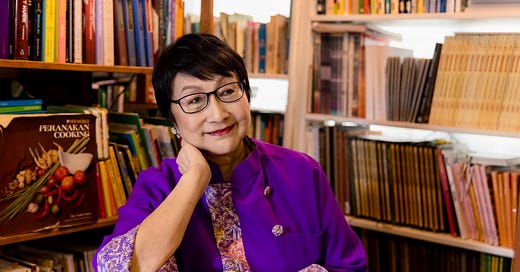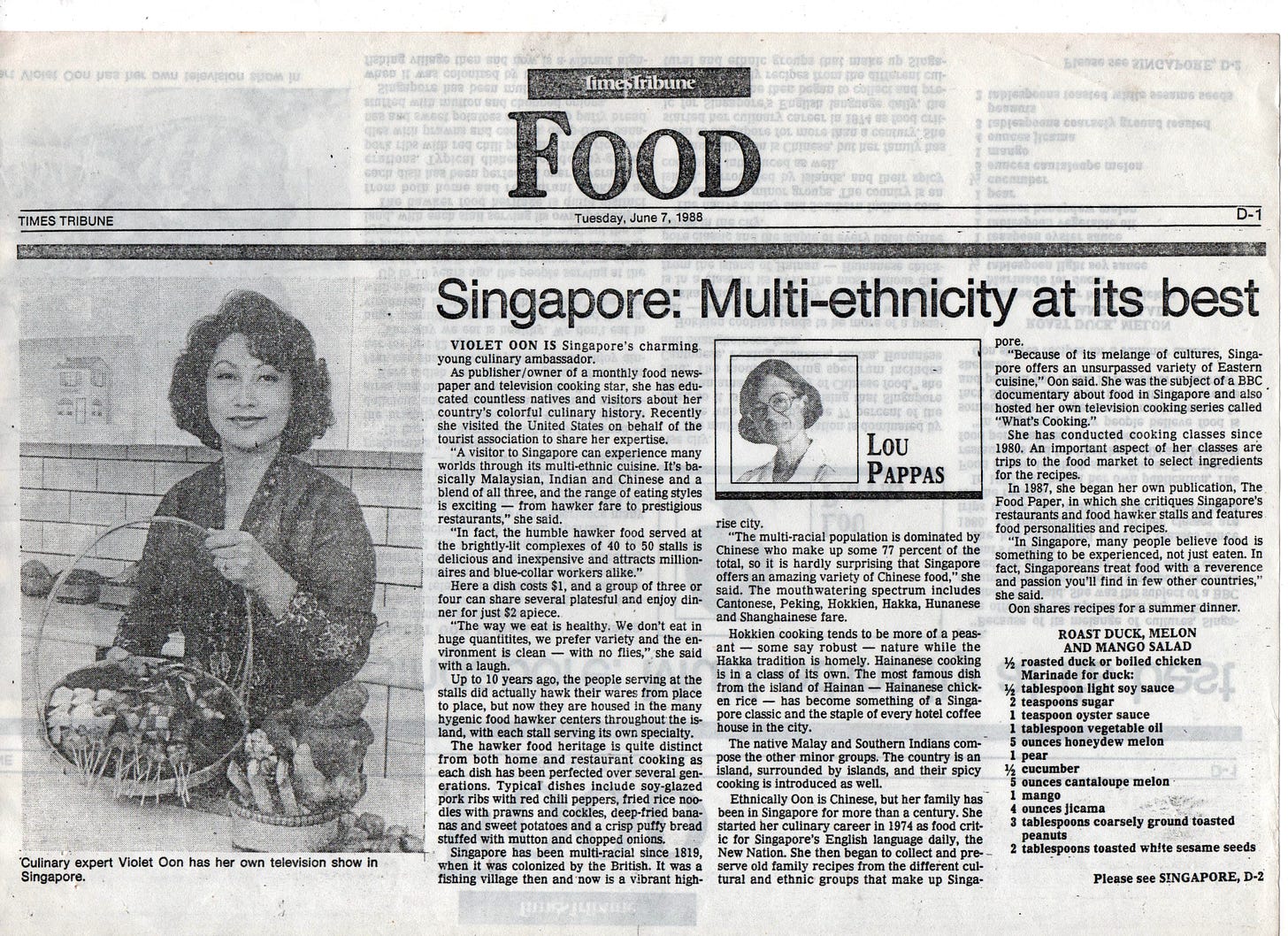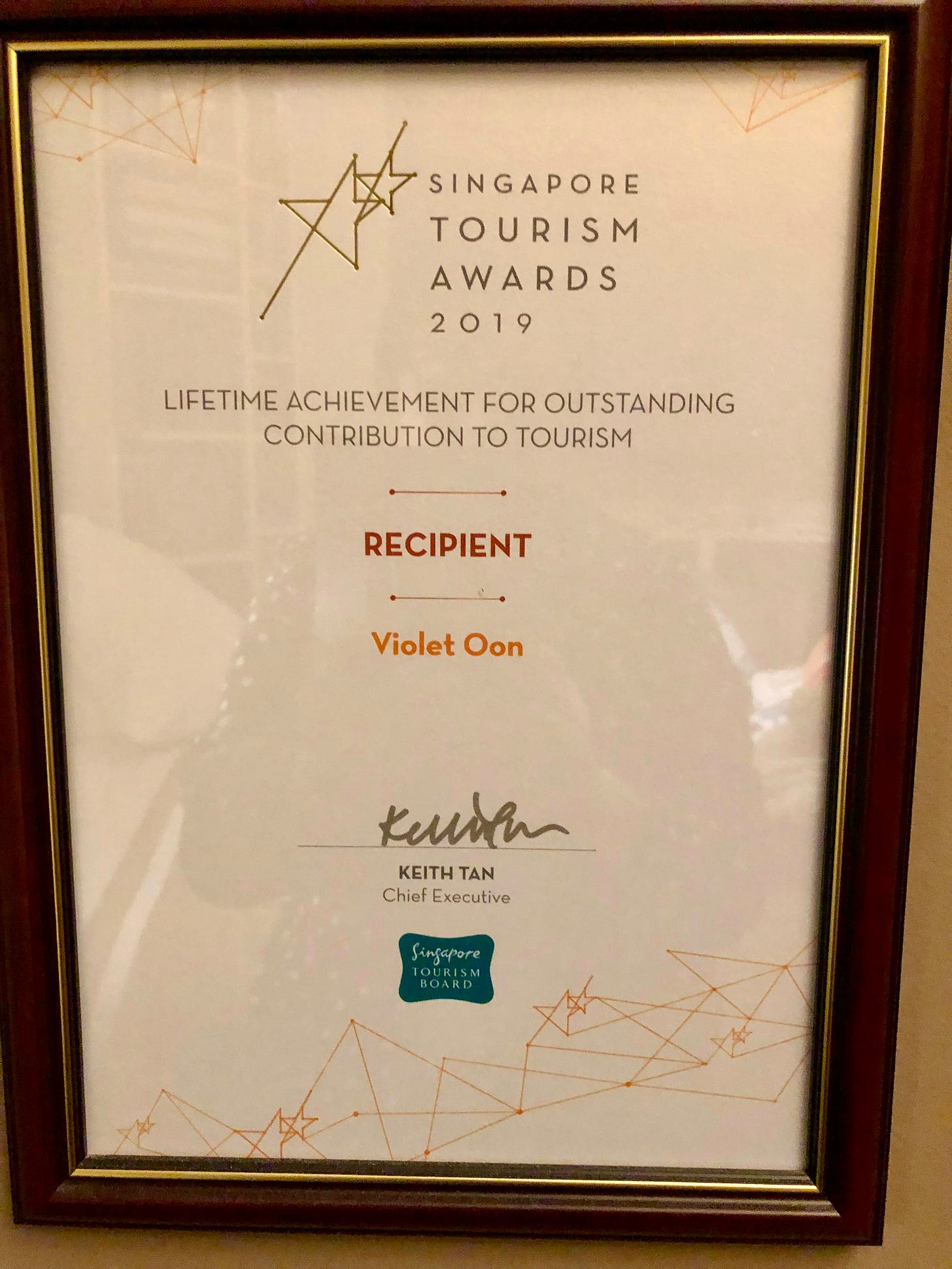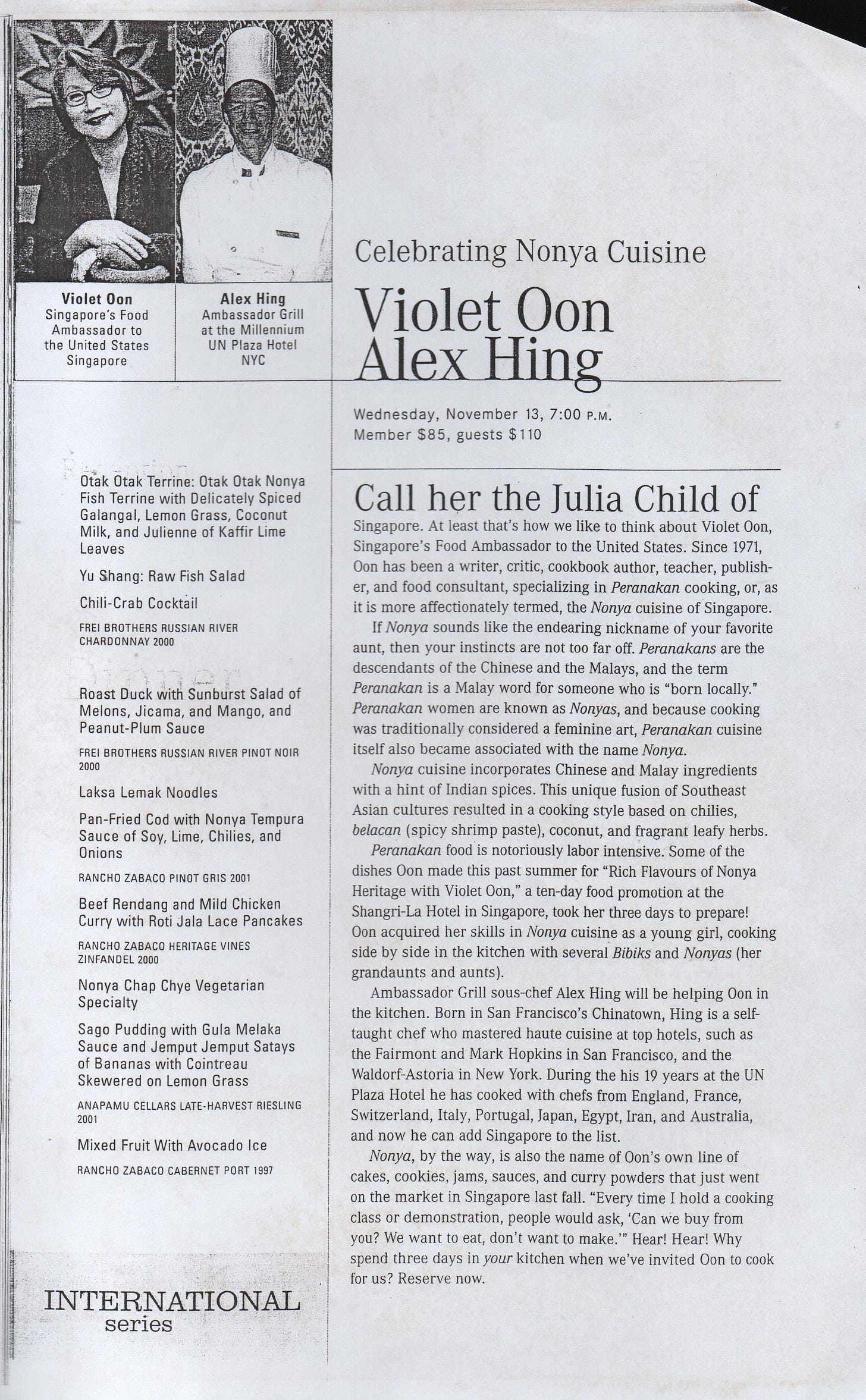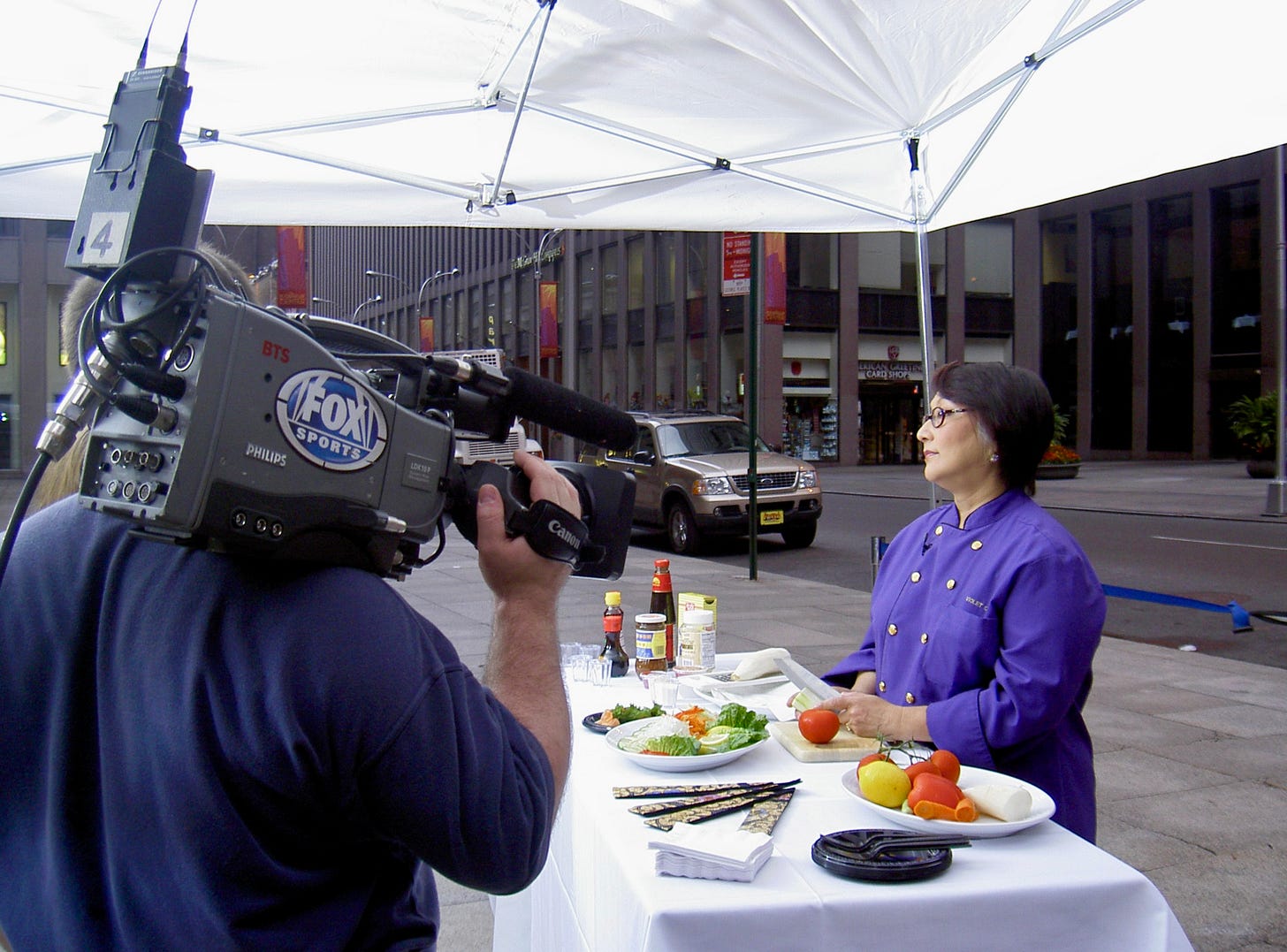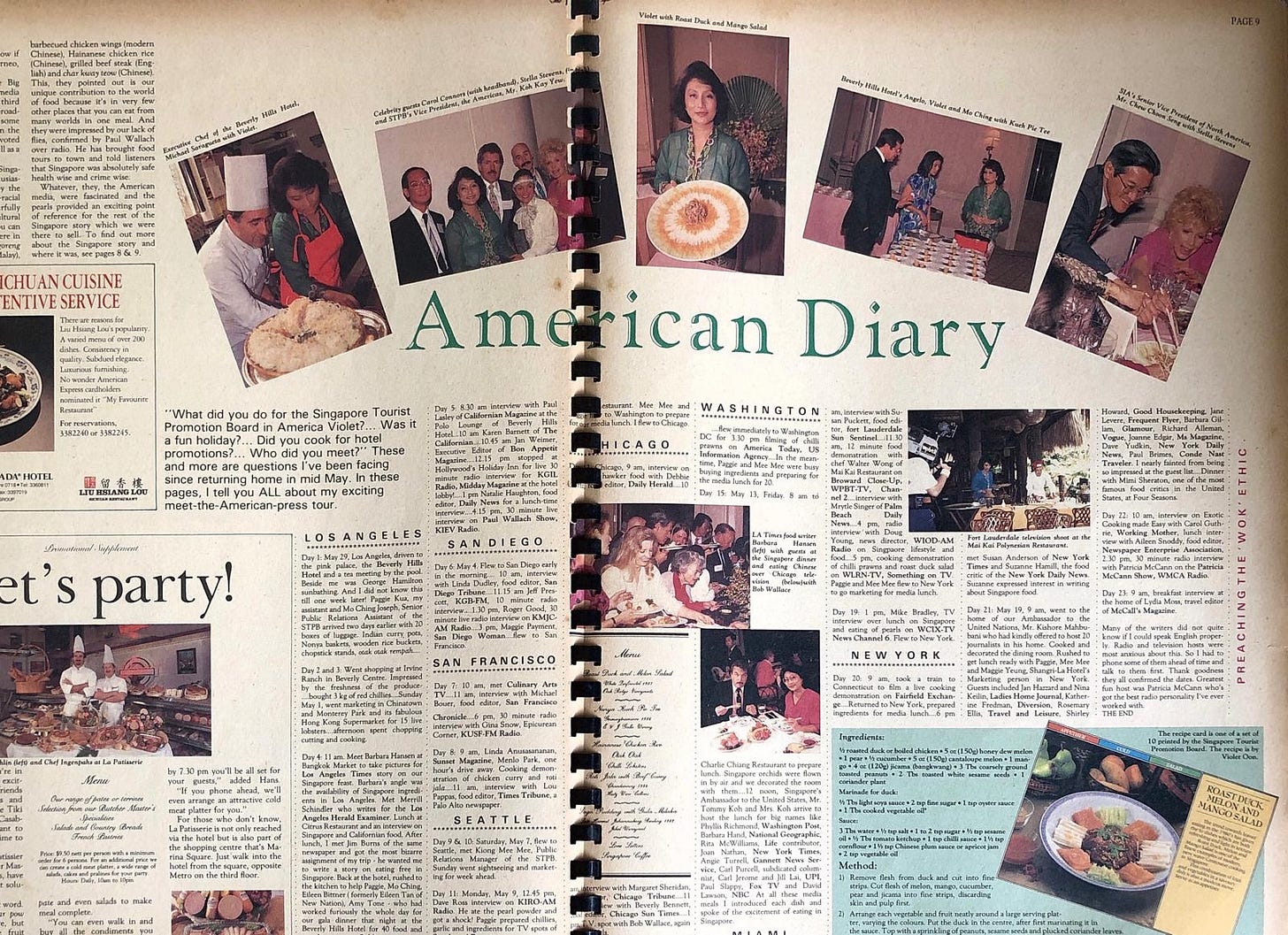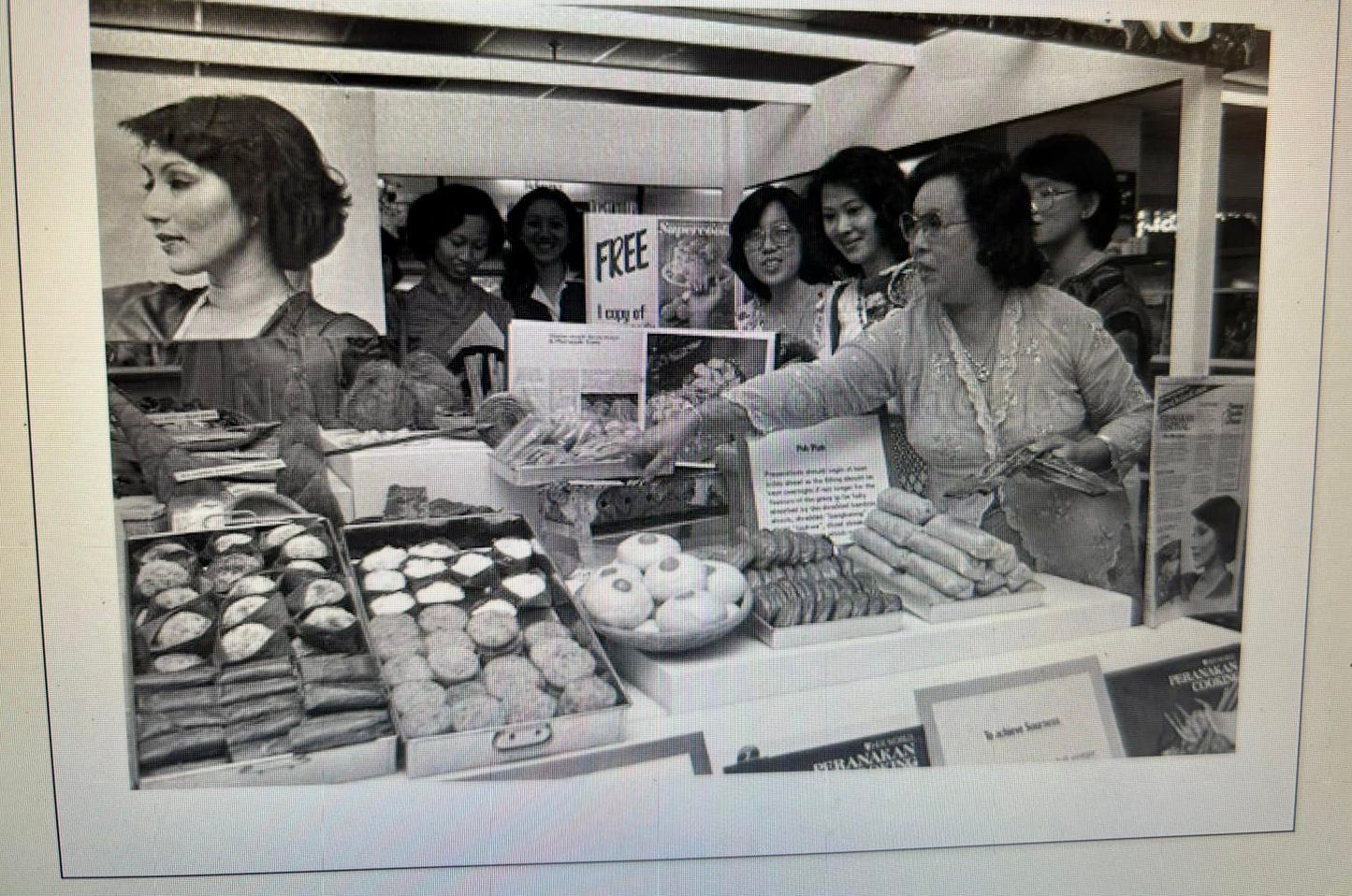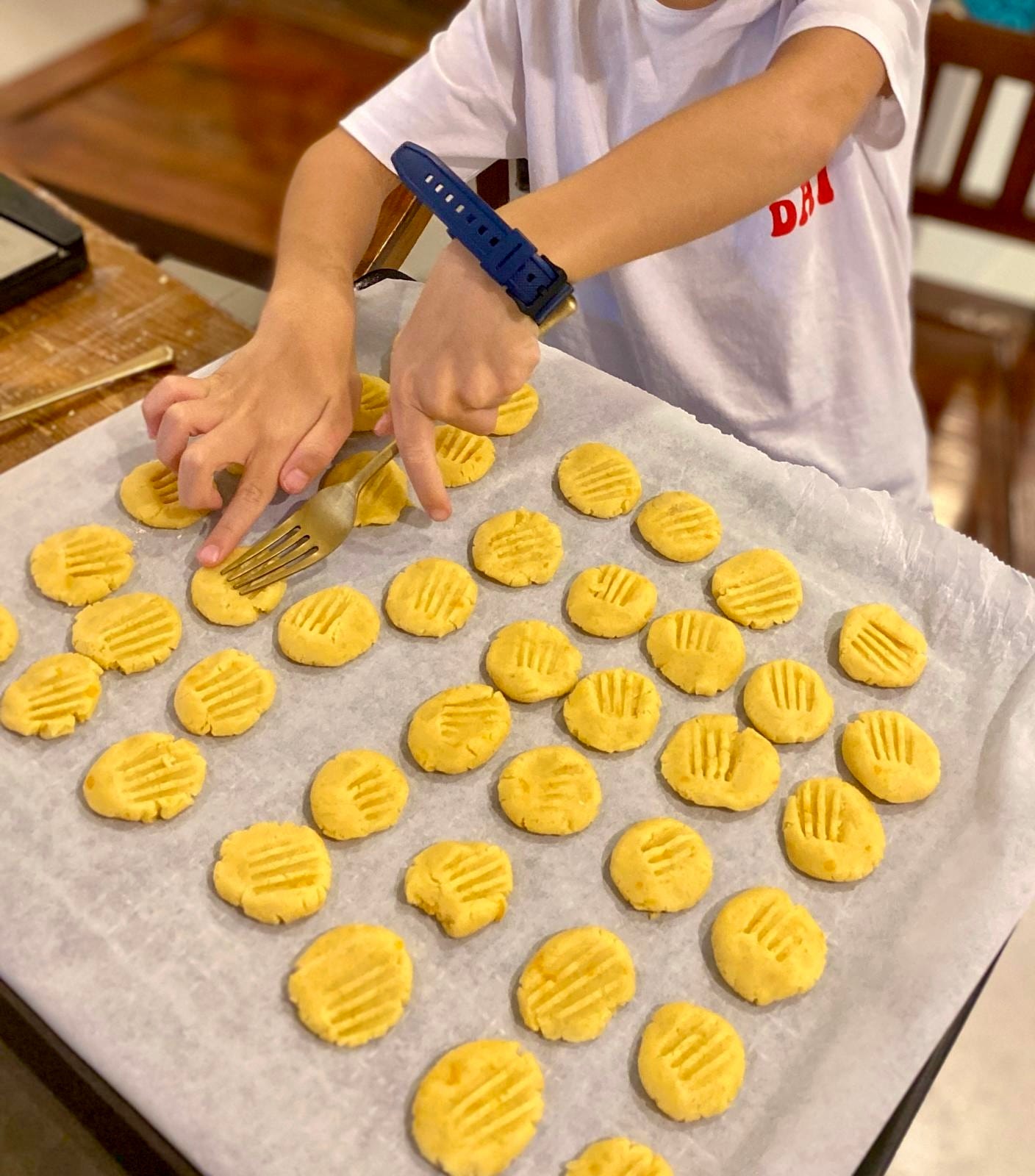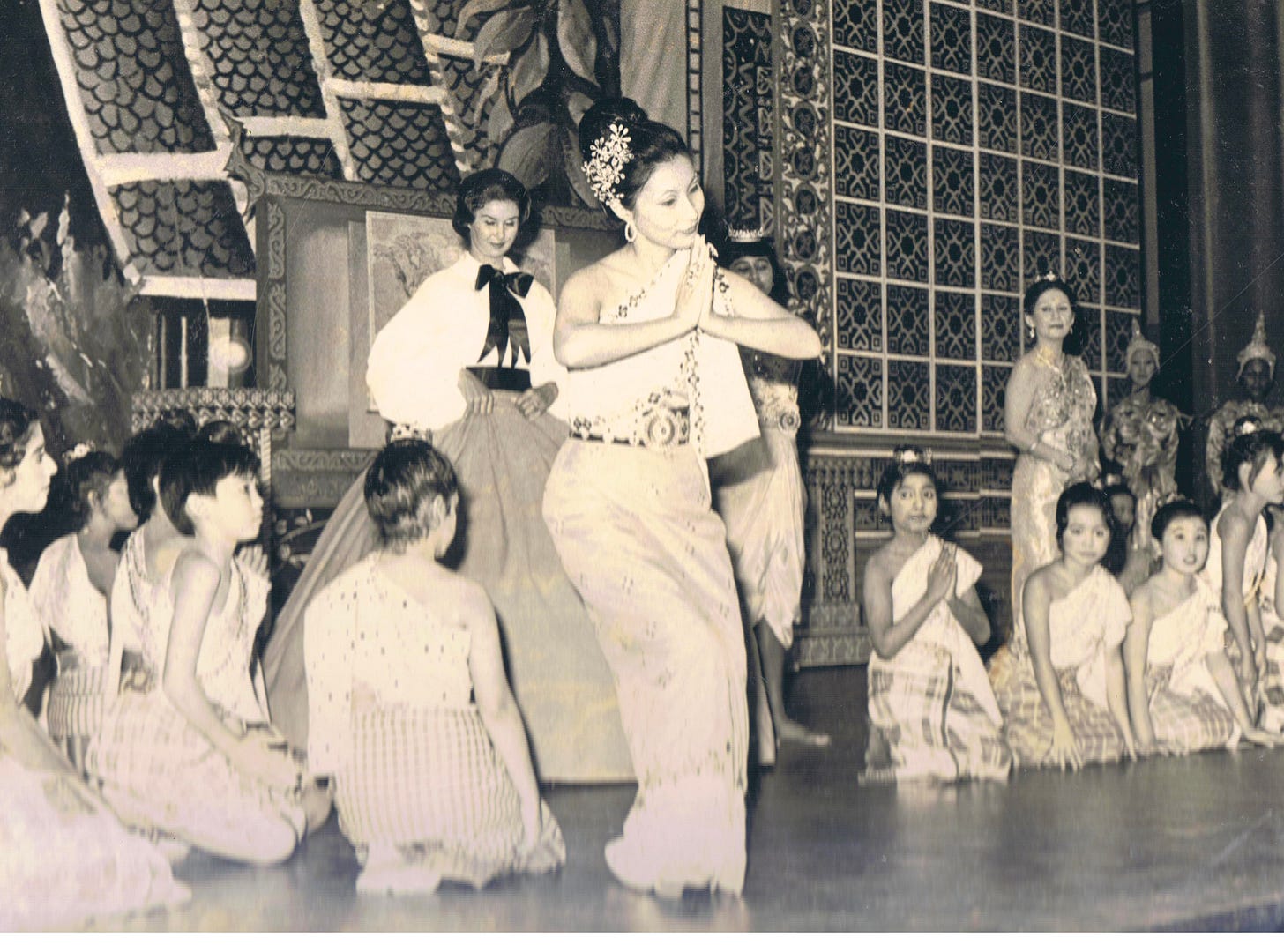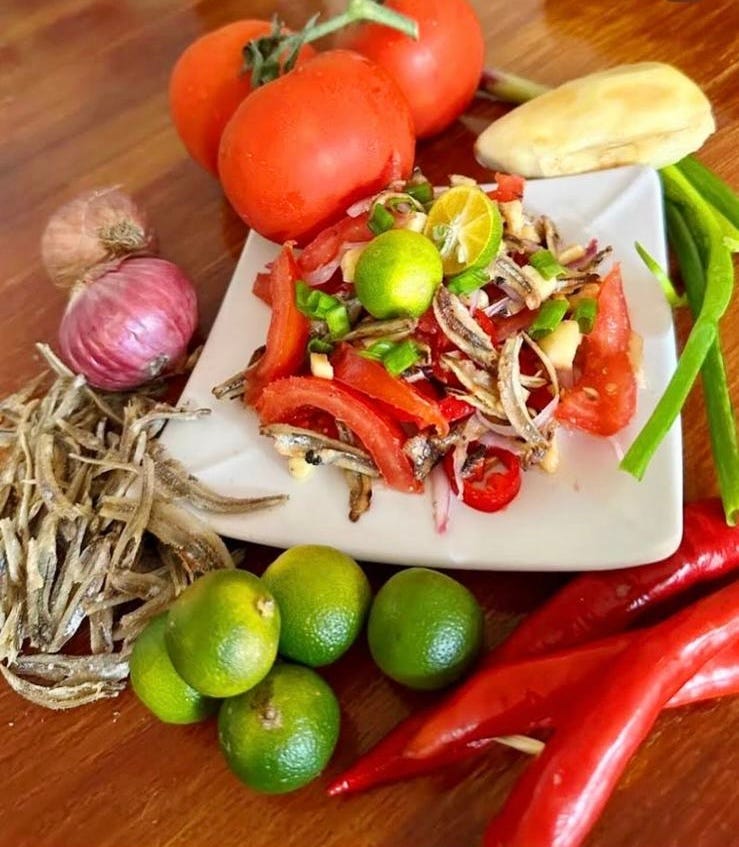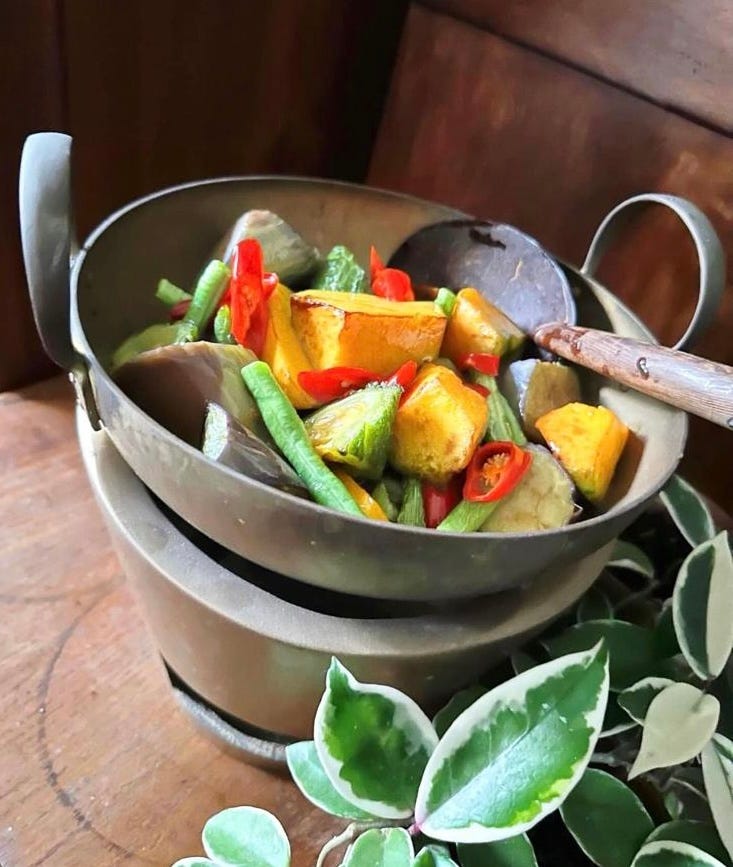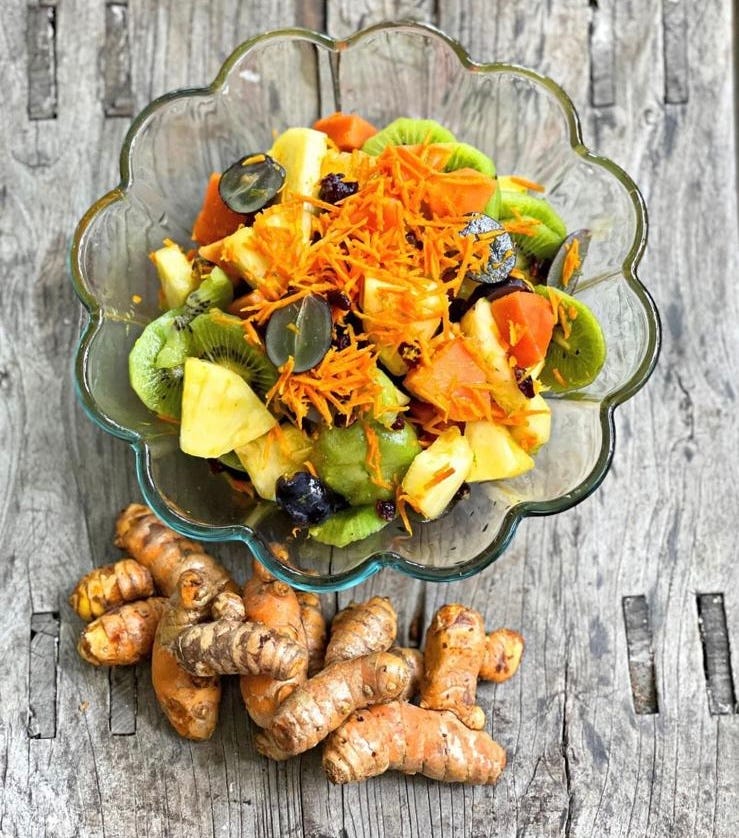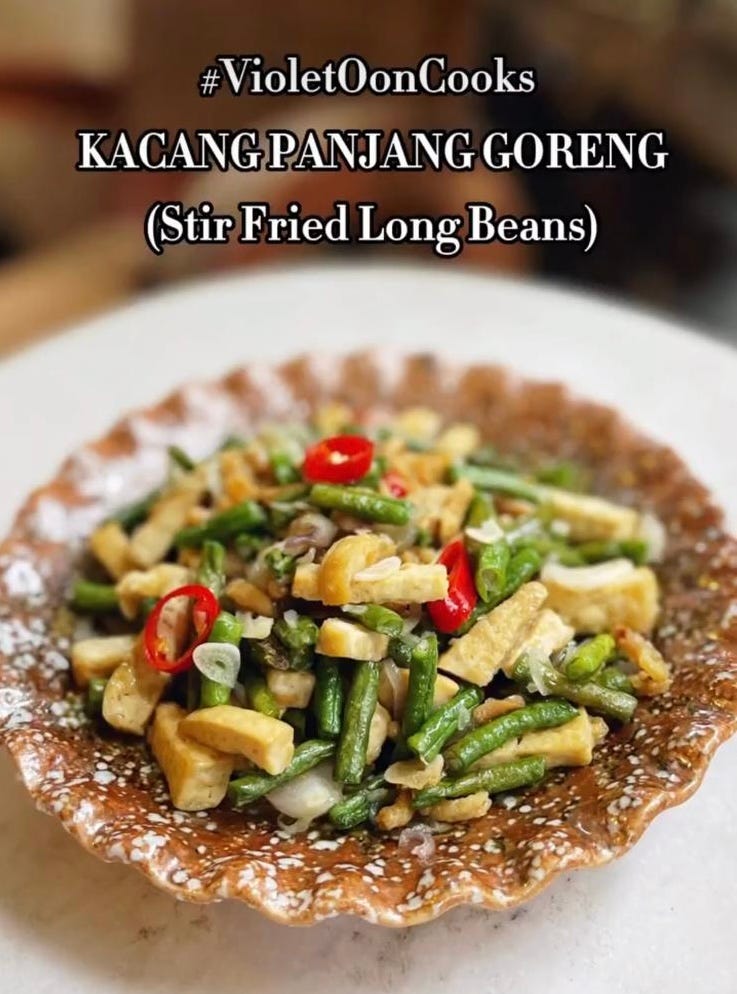I asked Violet Oon for a mini-interview and I got a mini-autobiography. How cool is that?
Violet Oon is a household name in Singapore for her journalistic career as a food writer in the 1970s and for authoring one of the earliest cookbooks on Peranakan cooking. She became the first culinary ambassador for Singapore, promoting not just Peranakan food, but also hawker food and Singapore’s heritage dishes, around the world.
I had always planned and hoped that Violet would be my interview guest for May because of Mother’s Day. She is a dedicated grandmother who is extremely delighted that her grandchildren want to learn to cook from her. She has raised two incredible children who are now the architects of her business enterprise. And in a way, she is now a matriarch of our Peranakan cooking narrative, following in the footsteps of those before.
What makes this all the more special is that Violet just celebrated her 75th birthday. This interview could not have been more timely.
The wonderful news for those who have been searching for out-of-print copies of her cookbooks, is that Violet in working on a new edition of her cookbook.
This interview is amazing as it covers her childhood, her love for singing, what she values in friendships, audio accounts of her trips as Singapore's food ambassador and her healthy lifestyle which is perhaps the most relevant to many of us now.
Do not rush through it. Savour it all with a nice cup of tea, and maybe some kueh lapis too.
Growing up, what did you learn from the strong women around you, such as your mother and aunts?
My mother NANCY OON (nee Khoo Beng Neo), I have realized in these last 10 years of my life, was a pretty unusual woman for her day and belonged to that group of women, many of whom studied in Raffles Girls’ School in pre-World War II. They considered themselves to be the elite of women in Singapore and aspired to an education and a career. My mother went to Joan Tookes Secretarial College in Raffles Place, then the centre of the universe of Singapore, and subsequently became a “high powered secretary”. (Her words, not mine.)
With her friend Jenny Gan, who became Singapore’s TOP SECRETARY in SG post-WWII with a shorthand speed of 200 words per minute to my mother’s 190 (I think), she was secretary (now known as Chief of Staff) to Shell Company’s top boss.
In WWII, my mother somehow found herself in Indonesia and also in Singapore, where she was secretary to a Black Market King and this meant she had access to RICE and many people kissed her ass for this precious commodity.
After WWII, she met my father, a Raffles College grad and they married in 1947 with a party at the Chinese Swimming Club and also a dinner at the Wing Choon Yuen restaurant in Great World Amusement Park. [The restaurant is now known as Spring Court.]
My parents were “liberated” and highly interested in politics. My mother said that she was the secretary to David Marshall when he was Chief Minister of Singapore but could not take the pressure and so left the job.
My father’s “high-powered job” (Again, her words, not mine.) in Shell as the first local executive, took us to two stints in Malacca, first as Asst. Manager in the early 1950s where my mother was secretary to the governor of Malacca. During the second stint from 1956-1958, my father was the manager and my mother had to give up her job to be the perfect corporate wife – entertaining and overseeing a household of a cook and housekeeper, a driver and four gardeners.
It should have been paradise but it was not enough for her because although her husband could buy her diamonds, she wanted to earn money to buy HER OWN diamonds, like Aunty Suzanne who worked in OCBC (Overseas Chinese Banking Corporation).
My mother was a women’s libber before history caught up with her. She was an only child and so am I. My mother never cooked during my childhood and was super proud of not being able to even boil water. It was below the dignity of a career woman. She went into a frenzy of cooking classes in 1961 to prepare for my father’s posting to London and became a famous cook - of Fried Rice and, Sweet & Sour Pork - amongst the WI (Women’s Institute of London) which is like our People’s Association in Singapore, but for women.
Two of my father’s sisters worked as clerks/secretaries – my Ma Koh (father’s eldest sister) Mrs. Nona Bong, who went to work every day in Raffles Place in a sarong kebaya and my Ko Chi (youngest paternal aunt)– who did not wear a sarong kebaya to work.
My Ma Koh was the chef of the family. Her Peranakan cooking was legendary and we looked forward to our feasts each Sunday while in Singapore.
I learnt to cook from my Ma Koh, and my grand aunt by marriage, Mrs. Nanny Khoo (nee Zecha) who was from Indonesia. She was legendary too and every day, she made two exquisite Kueh Lapis* which her husband (my maternal grand uncle) Mr Khoo Heng Loon, would walk down Emerald Hill to Cold Storage where her Kueh Lapis were sold.
I had powerful women in my life – each invested in their own character and personality.
*A beloved Dutch-Indonesian baked layer cake with spices that include cassia, star anise, cloves and cardamom.
As a journalist, what made you zero in on food writing?
It was by happy happenstance. The food column became available and my editor David Kraal said, “I think we better have someone who can actually COOK to be our food critic.” My whole career in journalism has been quite rooted in criticising other people’s work, first as a music and arts critic and then, as a food critic. At the same time I was a feature writer.
What has been your proudest achievement in life?
A few – my children and grandchildren, amaze me with how they have turned out. I could not wish for any different.
Also my LIFETIME ACHIEVEMENT FOR OUTSTANDING CONTRIBUTION TO TOURISM, awarded to me in 2019 out of the blue. It was and still is a source of immense pride, YET at the same time, it is the source of a continued sense of commitment and responsibility deep in my heart, as I feel I have to continue to be worthy of this accolade.
ALSO, my award as INSPIRATIONAL PATIENT 2021 from the Singapore General Hospital (SGH). I had a stroke in 2014 and strive for positivity and to see how my experience can be of use to help others.
What or where is the most wonderful experience you’ve had as a culinary ambassador for Singapore?
Perhaps my first stint as SINGAPORE’S FOOD AMBASSADOR IN 1988. THREE WEEKS, NINE CITIES AND I EVEN CARRIED A BAKUL (BASKET) OF LIVE CRABS ON TO THE PLANE FROM CHICAGO TO DETROIT.
[Listen here to Violet’s memories of her amazing experiences as a culinary ambassador.]
What is your favourite hawker dish and why?
It has to do with sentiment and happy happy memories. One of the fondest food memories is having Sunday morning breakfast of Nasi Melayu** with my father at the Malay stall in the coffee shop at the corner of East Coast Road and Ceylon Road. This super fond memory has, I think, more to do with the special time I had with my father than the actual food itself though the food was, of course, awesome. Till today, while in a hawker centre or food court, I seem to gravitate towards the Nasi Melayu stalls.
**Literal translation is Malay Rice. White rice with a choice of sides that range from spicy chicken in gravy, beef rendang, stir-fried or braised vegetables, fried fish with chilli paste and egg.
What is your favourite Peranakan dish and what memories flood back to you when you have it?
NONE. Too many to pick up ONE. It is the experience of the meal itself.
FAVOURITE PERANAKAN DISH: There is no favorite Peranakan dish of mine. Because to me, “Peranakan food’ is actually where a meal is the whole experience of eating Peranakan. It has to have a variety of the dishes representing the perfect marriage of East and East between Chinese and Malay cooking with complementary as well as opposite characteristics of Chinese-based soy sauce and Hokkien-based flavours and texture and the lawan (battle) of a marriage between opposites, like the spice-based flavours of Malay cooking and the opposing yet married textures. And so, the meal to me has to have something sort of spicy hot and coconutty creamy like a Satay Ayam Goreng (Stir-fried Chicken in Spicy Coconut Milk) AND something spicy and hot and sour like an Ayam Buah Keluak, and something Chinese and crispy like Ngoh Hiang (Fried Five-Spice Pork Rolls in Bean Curd Sheets) because that adds another element to the meal. And then something with the Chinese flavour which might have taucheo (fermented soy bean paste) and garlic paste like a Chap Chai (Vegetable Stew). So to me, that constitutes a Peranakan meal rather than a favourite dish as THE MEAL is the ACTUAL POINT OF EATING PERANAKAN.
As a businesswoman, what advice would you give to those keen to start a food business?
I am actually not a businesswoman. I am more of a cook and curator of the food of my culture. As a business person, I did not do as well as I do in the CREATIVE SPACE which may not match with the BUSINESS SPACE. My advice is to have two grown-up children with the drive, acumen, creativity in food and business to launch the business with you! HA HA HA HA!
Your grandchildren love to cook. What special recipes would you want them to learn from you?
One grandson, F, now 13, wants to learn Po Po’s (maternal grandmother) heritage and this means the world to me. The rest want to learn some of Po Po’s heritage and to always EAT Po Po’s heritage-dishes which are my Peranakan and Singapore repertoire plus bits and pieces from all over my travels as well as their maternal grandfather’s Hokkien dishes which I learnt from my late mother-in-law when helping her cook the Chinese New Year reunion dinner in Malaysia.
The recipes number at least 100 and my grandkids have learnt how to make Pineapple Tarts as well as other cakes. The 13 year old “chef” has learnt Laksa, Mee Siam and Nasi Ulam (Rice Mixed with Fragrant Herbs) amongst others.
What do you enjoy in a friendship?
Laughter, loyalty and a good dose of not being impressed with each other’s success. Lots of jokes AND just being THERE.
What do you like to read?
Murder mysteries of the old school - Agatha Christie-type and the Italian murder mystery writers. The Italians have a laid back “bo chap” (relaxed, nonchalant) approach to life which is so realistic. The Scandinavians have a dark look at life which can be quite depressing. My reading is escapist, so I do not like psycho-types of books.
You love opera. What is your favourite opera and why?
Not actually full operas but more arias. I used to sing Puccini’s “O Mio Babbino Caro” and a few arias from “Madam Butterfly” - “One Fine Day” and “Tu Tu Piccolo Iddio!” Believe it or not, for a “Madam Butterfly” competition, my singing teacher, Mdm. Hwang Phay Ching, was foolish enough to enter me for and which I was demented enough to SING. She imagined I could qualify at…..age 19? Or 20?!!!
I have an affinity to “Carmen” because the aria “Les Tringles des Sistres Tintaient” won me the 3rd Prize for Mezzo Soprano at the Middlesbrough Eisteddfod in 1971(I think), along with Purcell’s “When I Am Laid In Earth”.
“Carmen” was an opera I saw in full splendour at the premier of Franco Zeffirelli’s production at the Vienna State Opera House when I was invited to Vienna as a music critic by the Austrian Ambassador. I witnessed Vienna’s glamorous opera scene where the audience was as lushly-dressed and coiffed as the singers on stage. That spoilt me forever as OPERA for me meant exquisite style and glamour on and off stage and post-theatre outside. The production had REAL HORSES on stage and I was told that many women dyed their hair red or blonde to be captured on TV cameras.
I also saw “Carmen” in Moscow on the Bolshoi stage when I went as a reporter with the Singapore dance cultural exchange in 1972 in the deepest dark days of the Soviet Union. Such adventurous times.
Of all the heroines in opera, which one do you most identify with.
Perhaps Carmen and the super tragic Mimi of “La Boheme”. That story was so lyrically tragic.
Given that you have overcome a stroke, what advice can you give to lead a healthy lifestyle, in terms of what we eat, how we exercise and how we manage stress?
I had a stroke exactly 10 years ago in June 2014. It was at night and I was walking in my apartment hallway. I suddenly felt my balance leach out of the left side of my body, hung on to the wall, sat on the floor and called my housekeeper. I did not want to fall. My son and his then girlfriend, now wife, a doctor, came over and she said, “Perhaps ‘cerrabellar’”. It sounded romantically Italianate to my Italian opera-enamoured self but it was a blood clot in the part of the brain with the balance function. Until today, I do not have balance. It is very difficult to describe but I cannot step up one step without losing my balance. Therefore, I practise every time I walk - my mind, then my limbs re-calibrate with each step, like a robot! Sometimes, I can let go in my mind and not be conscious. My neurologist says that with a stroke, that part of your brain with the blood clot dies forever but the human brain is fantastic, it grows fibres around to replicate the function that has died.
I stayed in hospital, SGH, for 5 weeks, and had to re-learn how to walk and went for physio down the corridor twice a day.
I knew that my diet had to change immediately and was the most compliant patient as I can view eating as a function. My very enlightened father put me, in 1961, in CHIJ (Convent of the Holy Infant Jesus) Victoria Street for Secondary 1 boarding school. He said, “Anyone can get used to a life of luxury overnight but you better be prepared for WWIII!” And nothing prepares one for WWIII than a convent boarding school in the 1960s. The food was totally dreadful amongst other dreadful stuff.
So though I was brought up to eat the most exquisite foods since childhood - we went on holiday every year since the time my parents got married in 1947 and then I became a food critic in 1974 and made food pilgrimages to France, New Orleans etc. - I can eat totally for function and enjoy it.
First, at the hospital, I even had to eat purée food. Puréed meat, veggies etc. and jelly water for up to three months because I ran the risk of choking. Less salt, less sugar, no oil. I think I was and am the only patient in SGH history who NEVER SMUGGLED FOOD into my room….
I realised at once my diet must change and, being previously bad enough to have to adjust to no salt, no added sugar, no oil, my food now must LOOK BEAUTIFUL - as one eats with the eyes first.
I made sure everything I ate - mainly veggies, fruits, steamed fish and boiled eggs - looked beautiful and each plateful had to and still consists of food of a few colours.
Until today, I eat this way at home and indulge in yummy food with no restrictions when I go out except that I limit the quantity I eat as my stomach now gets full very easily through the practice of eating less quantity of food over the years.
One’s tastebuds adjust and I got to enjoy the ACTUAL TASTE of each natural food. My soups are not salted or very lightly salted, for example. My whole stomach got used to this new way of eating. I love raw veggies, for example.
When eating out or enjoying the rich Peranakan food in my restaurants, I find that I can savour each flavour and texture more intensely. Everything is heightened and the nuances of food are more revealed.
THE UPSIDE: I think my nice skin complexion at age, now 75, and the firm tone of my skin, come from this practically ascetic diet. WABI SABI?
EXERCISE? Oh dear! I spent my whole life avoiding exercise so the inability to dance, jump and do cartwheels did not impact me as sadly as it does for many stroke survivors who are more used to a sporty lifestyle, like playing tennis or running.
I am now 75. These past few months, under the eagle-eyed care of a body therapist who has done wonders for my balance and has managed to unlock the muscles and nerves, I am moving better now. I will aim for 10,000 steps a day, not just 5,000. I think the best place for me to walk is in the bowels of the MRT (Mass Rapid Transit) stations when changing train lines. It is safe for my balance compared to the Botanic Gardens in my backyard or on roads with their uneven surfaces.
STRESS. Fortunately, I was prepared to be ready for a life of hardship by my very forward-thinking late father Oon Beng Soon. Furthermore, when I think of refugees and people living with no food, no running water or modern toilets, in war-torn countries, the stress just fades away because I am grateful for how lucky and blessed we are.
P.S. I used to have to go to the outhouse toilet in the middle of the night in the deep dark backyard in my aunt’s bungalow in Klang - with unknown creepy crawlies. YUCKS!!!!
What would you like to be remembered for?
NO ANSWER. Perhaps a fun, understanding grandmother - six grandkids ages 1+ to 17 - “who love me just for being me.” And hopefully, my children know me as an understanding, supportive and loyal loving mother.

